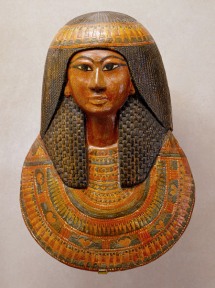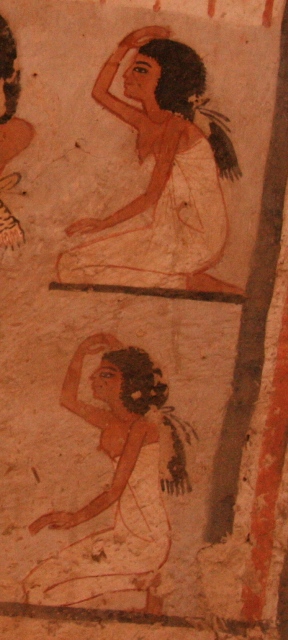The chapter 531 of the Coffin Texts treats about the prophylaxis of the different parts of the funerary mask, always assimilating them with many divinities. After saying how perfect is the face (that is the mask) of the dead we read:
“Your White Crown is Thoth; your crown is Wp-wawt[1]. Your eyebrows are both Enneads. Your eyes are the boat of the day and the boat of the night.
Your two locks of hair are Isis and Nephtys.
Your nape is Duanenuy. Your plait is Hddt
The funerary mask is like a complete head, or like its substitute, and to put it on the deceased’s face is a revivifying action. The dead is assimilated to the acephalic Osiris and the mask has two functions. On one hand it hides the damage made by Seth on the Osiris’ face; on the other hand it restores the faculties to the head, as to see and to breath; through the mask the dead can also perceive things that mortals cannot notice[2]; the replacement of the head, symbolised by the placement of the mask, allows the deceased to come back to life.
Scholar D. Meelks translated the word swt as “lock” or “plait”[3]. Due that the chapter is describing the funerary mask; we could think that this word would be making an allusion to the two locks of hair that fall on both sides of the face; in the same way that Isis and Nephtys are always at both extremes of the dead.

Khonsu’s funerary mask. XIX Dynasty. Metropoliltan Museum of New York. Photo: http://www.metmuseum.org
Let’s remember also that we have already seen how the word swt designates the front lock of hair the mourners pull. Maybe both locks of hair were assimilated to the hair the two goddesses pull from.
In the wig both locks of hair fall at both sides of the face while the rest of the hair falls over the back. The term hnskt usually means “plait of hair”[4]. But in the context we are the two locks of hair are assimilated with Isis and Nephtys, and just before the text mentions the nape, so it makes sense to think of Hnskt as the mop of hair that in the wig falls on the back[5]. On the other hand, the term Hnskty is a dual that means « the two women with plait », Isis and Nephtys[6]. And that refers us to those images of Isis and Nephtys with the head-dress afnt (see image in header) or to those images of mourners with the hair tied in a back tail; , which would reinforce the idea that hnskt could be that hair identified with the goddess Hddt (a kind of Isis in Edfu).

Mourners with hair tied in a back tail. Painting from the tomb of Roy in Dra Abu el-Naga. XVIII Dynasty. Photo: Mª Rosa Valdesogo Martín.
At this point we consider important to point out a scene of a libation on an altar in Dendera. In it the spelling of Isis Hddt is changed by another one that refers to a light symbolism. We are in a context where the mission of Isis is to bright in the sky just in the moment of bringing the flood[7]. That makes us think about what we have seen in former chapters about the nwn gesture and the beginning of the Egyptian year; the nwn gesture would be a way of symbolising the new flood, the new year and, therefore, the new life. Again we would be facing the hair element with a strong regenerating symbolism.
[1] “The One who open the ways”, the name of the jackal god from Asiut, that opens the ways to the king in the battle. Let’s think about its presence also in the Sed Festival.
[2] D. Meeks, 1991, p. 7.
[3] D. Meeks, 1977-1979, II, p. 312, nº 78.3373.
[4] Wb III, 116, 4.
[5] Chr. Desroches-Noblecourt considers that Hnskt refers to the small braids under the head-dress afnt (Chr. Desroches-Noblecourt, 1953, p. 28, n. 2) and that it is related with the manifestation of the deceased’s ka (Chr. Desroches-Noblecourt, 1953, p. 25, n. 5). The mother of the dead in funerals wears the head-dress afnt: “Your mother is the great cow in el-Kab, (with) the crown Atef and head-dress afnt, with long hair, with hanging breasts, which has nursed you” (Pyr., 2003).
[6] Wb III, 121, 1. It appears like that in The Songs of Isis and Nephtys, Pap. Bremner-Rhind I; 1,9; 3,23; 6,23 y 11,19.
[7] M-Th. Derchain-Urtel, 1993. Leuven, p. 102.


